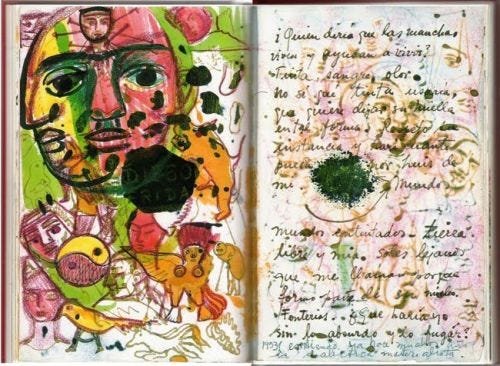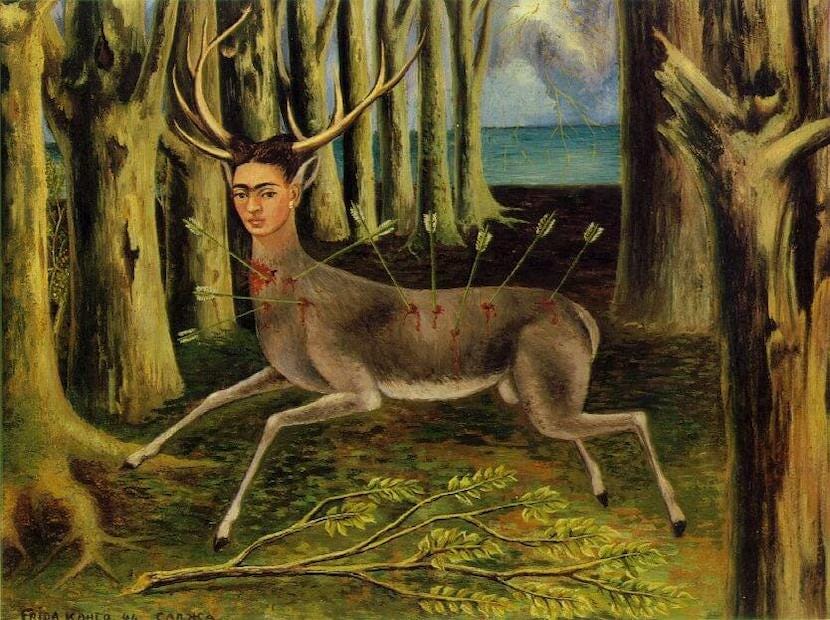Wonderland was not the first image to come to mind. Instead, I pictured the movie, Pan’s Labyrinth by director Guillermo Del Toro. Only, as the little girl descends into the earth, she finds not a fawn but herself. This is the memory Frida Kahlo shares in her illustrated diary.
“I ran with my secret and my joy to the farthest corner of the patio of my house, and always to the same place, under a cedron tree,” she wrote. “I would shout and laugh, amazed to be alone with my great happiness with the very vivid memory of the little girl.”
It’s her joy that astonishes me and holds my imagination—her sharp emotional response rather than the peculiarity of her journey. If I were to meet myself, my response could not possibly be so ecstatic.
This article is part of Literary Salon issue #5.
The Origin of the Two Fridas
From the Diary of Frida Kahlo
== Memory ==
I must have been six years old
when I had the intense experience of
an imaginary friendship
with a little girl… roughly my own age.
On the window of
my old room,
facing Allende Street,
I used to breathe on one of the top panes.
And with my finger I would draw
a “door”……
Through that “door”
I would come out, in my imagination,
and hurriedly, with immense happiness, I would
cross all the field I
could see until I reached
a dairy store
called PINZÓN… Through
the “O” in PINZÓN I entered
and descended impetuously
to the entrails
of the earth, where
“my imaginary friend”
always waited for me. I don’t
remember her appearance or her
color. But I do remember her
joyfulness — she laughed a lot.
Soundlessly. She was agile,
and danced as if she
were weightless. I
followed her in
every movement and while she
danced, I told her
my secret problems. Which
ones? I can’t remember. But
from my voice she knew all about my
Affairs. When I came
back to the window, I would enter
through the same door I had
drawn on the glass. When?
How long had I been
with “her”? I don’t know. It could
have been a second or thousand of
years… I was happy. I would erase
the “door” with my
hand and it would “disappear.” I ran
with my secret and my
joy to the farthest corner
of the patio of my house, and
always to the same place,
under a cedron
tree. I would shout and
laugh Amazed to be
Alone with my great happiness
with the very vivid memory of
the little girl. It has been 34 years
since I lived that magical
friendship and every time
I remember it it comes alive and
grows more and more inside
my world.
PINZON 1950. Frida Kahlo
LAS
DOS
FRI-
DAS
This particular entry is also available as a children’s book.
Columbus Museum Store: (The children’s book, The Two Fridas, is available wherever books are sold, but the Museum Store is where I discovered it.)
The Diary of Frida Kahlo is available on Amazon, but you can explore it for free at Internet Archive.
I Ran with My Secret and My Joy
I must have been six years old.
Frida was diagnosed with polio at age six and was confined to her bed for nine months. It crippled her right leg and left her with a limp.
It has been 34 years since…
While in preparatory school, hoping to study medicine, she was impaled in a horrific bus accident that killed many of the other passengers. Her injuries required over thirty surgeries across her lifetime and turned her life’s calling from medicine to painting.
My paintings carry with them the message of pain.
— Frida Kahlo
Frida was famous for her introspection, and when, in her childhood, she climbed down into the bowels of the earth, the little girl she found was herself, something perhaps only adult Frida could recognize. The self she found was full of silent laughter and would dance as Frida told her all her secret problems. When she returned, she brought her secret self’s joy with her.
When we look back at ourselves as children, we’re looking through years of gain and loss, of horror and joy—all the many scarring emotions. All that experience and all its sadness stand on a foundation of innocence and wonder.
Perhaps, much of what we create is a conversation between those selves. Inside each of us are two Fridas, and only one of them is innocent and full of joy. In that juxtaposition, in that contrast, art is born.
— Thaddeus Thomas
Read my essays on Prose Style and Literary Theory here.
The book version is coming soon.
P.S.—I sent another accidental email last night. Subscribe anyway.









are you making it into a book Thaddeus?? one guaranteed sale here!
This is absolutely fascinating. Thank you. I’m so glad I took the time to read it!